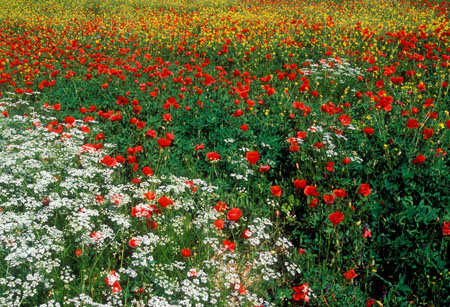The flowers we see on a journey are often rare or unknown in our home country, and may therefore be seen as symbols of a particular destination. The edelweiss, for example, is not seen throughout most of Europe but can be found high up in the Alps as the snows recede. Its rarity only adds to is iconic status in the region.
 Carpets of flowers, such as those found in spring in alpine meadows or on the flowering scrub-land of South Africa’s Namaqualand, are easier to photograph than individual specimens. The sheer mass of blazing colour is the spectacle, and individual flowers are less important. Combine this scenic approach with the vastness of a blue sky or an interesting cloud formation, and a good image is virtually assured.
Carpets of flowers, such as those found in spring in alpine meadows or on the flowering scrub-land of South Africa’s Namaqualand, are easier to photograph than individual specimens. The sheer mass of blazing colour is the spectacle, and individual flowers are less important. Combine this scenic approach with the vastness of a blue sky or an interesting cloud formation, and a good image is virtually assured.
More difficult to photograph, particularly while travelling, are detailed studies of individual plants or blooms. A tripod, a remote release and a macro lens, or some form of close-up equipment, is more or less essential for work of this type since it is necessary to focus accurately and perhaps work within a half a metre of the subject. Flowers also move in the wind and blur if a shutter speed of less than about 1/125 sec is used. This can be a problem because a small aperture is a required to achieve sufficient depth of field. Ideally, a wind break should be erected to protect the specimen without casting unsightly shadows, but this may be impracticable for all but the most dedicated enthusiasts. Within these physical limitations, exposures are straightforward except where the subject is light and the background dark, or vice versa. Then it is necessary to take a spot-metered measurement from the flower and apply a similar exposure to the whole scene.
Where possible also look for additional environmental touches such as dew, frost or insects on the blooms, or the inclusion using a wide-angle lens of the surrounding landscape. The wide-angle approach is often possible, perhaps on a hillside or from a very low viewpoint, when flowers or leaves grow in clumps. It may then be possible to work far enough from the plant to achieve depth of field to infinity. Another quite different approach is to use a slow shutter speed to record or exaggerate motion blur and so achieve a dream-like impressionist image dominated by swirls of colour but showing very little detail.






